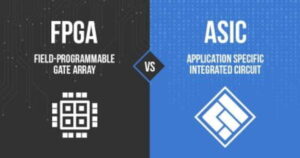Introduction
Embarking on an M.Tech in VLSI (Very Large Scale Integration) is a challenging yet immensely rewarding journey. The field demands a robust understanding of various foundational subjects that collectively build the expertise required for VLSI design and development.
This guide delves into the essential prerequisites for an M.Tech in VLSI, elaborating on each subject and its specific requirements.
1. Semiconductor Physics
Semiconductor Physics forms the bedrock of VLSI technology. A solid grasp of the following concepts is crucial:
- Band Theory: This explains the electronic structure of solids. Understanding the energy bands—valence and conduction—is fundamental to grasping how semiconductors work.
- Intrinsic and Extrinsic Semiconductors: Comprehend the differences between pure (intrinsic) and doped (extrinsic) semiconductors, which determine the conductivity properties of materials used in VLSI.
- Charge Carriers: Learn about electrons and holes, as well as how their concentration affects semiconductor behavior.
- Transport Mechanisms: Study drift (movement due to electric fields) and diffusion (movement due to concentration gradients) of carriers.
- PN Junctions: Understand the formation, characteristics, and behavior under forward and reverse bias conditions. This is pivotal for diode and transistor operations.
- MOSFETs: Master the structure, operation, and characteristics of Metal-Oxide-Semiconductor Field-Effect Transistors, the fundamental building blocks of VLSI circuits.
Read More: 8 Companies Poised to Benefit Significantly from the AI Boom
2. Analog Circuits
Proficiency in analog circuits is essential for designing and analyzing the continuous-time components of VLSI systems:
- Basic Components: Familiarize yourself with resistors, capacitors, and inductors, the basic elements of any circuit.
- Amplifiers: Study operational amplifiers (op-amps), focusing on small signal analysis and frequency response. These are critical for signal amplification and conditioning.
- Filters: Learn about low-pass, high-pass, band-pass, and band-stop filters, which are used to manipulate signal frequencies.
- Oscillators: Understand both sinusoidal and relaxation oscillators, which generate periodic waveforms used in clocks and signal generators.
- Noise Analysis: Grasp the concepts of noise in circuits and how to mitigate its effects to ensure signal integrity.
3. Digital Circuits
Digital circuits are the cornerstone of VLSI design, enabling the processing and storage of binary information:
- Logic Gates: Study the basic building blocks such as AND, OR, NOT, NAND, NOR, XOR, and XNOR gates.
- Combinational Circuits: Learn about adders, multiplexers, demultiplexers, encoders, and decoders, which perform specific logic functions.
- Sequential Circuits: Delve into flip-flops, latches, counters, and shift registers, which store and manipulate binary data.
- Finite State Machines (FSM): Master the design and analysis of FSMs, crucial for control logic in digital systems.
- Timing Analysis: Understand setup time, hold time, and propagation delay, which are vital for ensuring the correct timing of digital circuits.
4. Basics of Circuit Network Theory
A comprehensive understanding of circuit network theory is necessary for analyzing and designing both analog and digital circuits:
- AC and DC Analysis: Analyze circuits under alternating current (AC) and direct current (DC) conditions to determine their behavior.
- Transient Analysis: Study the circuit’s response to changes in voltage and current over time.
- Frequency Response: Use Bode plots and understand resonance to analyze how circuits respond to different frequencies.
5. Basics of VLSI Design Flow
Knowledge of the VLSI design flow is essential for transforming an idea into a manufacturable IC:
- Specification: Define the functional and performance requirements of the VLSI system.
- RTL Design: Develop the Register Transfer Level design using Hardware Description Languages (HDLs) like Verilog.
- Synthesis: Convert the RTL design to a gate-level representation, optimizing for area, speed, and power.
- Physical Design: Focus on layout design, placement, and routing to create the physical blueprint of the IC.
- Verification: Simulate and test the design to ensure it meets specifications and functions correctly.
- Fabrication: Understand the IC manufacturing process, including lithography, etching, doping, and packaging.
6. Verilog HDL
Proficiency in Verilog HDL (Hardware Description Language) is critical for designing and simulating VLSI circuits:
- Syntax and Semantics: Master the basic constructs and syntax rules of Verilog.
- Modeling Techniques: Learn structural, behavioral, and dataflow modeling techniques to describe the hardware at different abstraction levels.
- Simulation: Write testbenches and simulate designs to validate their functionality.
- Synthesis Constructs: Understand synthesizable constructs and constraints to ensure the design can be successfully implemented in hardware.
Read More: 6 Reasons Why Nvidia Overtook Apple as World’s Second Most Valuable Company – techovedas
Conclusion
Pursuing an M.Tech in VLSI requires a comprehensive understanding of several key subjects. Mastery of semiconductor physics, analog and digital circuits, circuit network theory, the VLSI design flow, and Verilog HDL is essential. This foundational knowledge equips students with the skills necessary to excel in the dynamic and ever-evolving field of VLSI design. Whether you aim to develop cutting-edge microprocessors, memory chips, or complex digital systems, these prerequisites provide the critical groundwork for your advanced studies and future career in VLSI.








